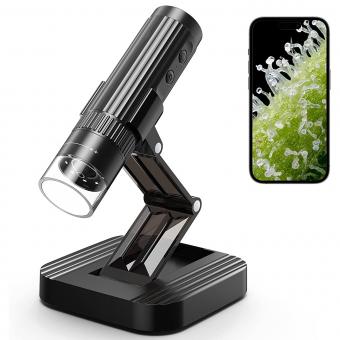What Is A Light Microscope Used To Observe ?
A light microscope is used to observe small objects or organisms that are not visible to the naked eye. It uses visible light and lenses to magnify the sample, allowing scientists to study the structure and behavior of cells, tissues, and microorganisms. Light microscopes are commonly used in biology, medicine, and materials science to study a wide range of samples, including bacteria, plant and animal cells, blood cells, and microelectronics components. They are also used in quality control and manufacturing to inspect the surface of materials and products. Light microscopes can provide high-resolution images of samples, but their resolution is limited by the wavelength of visible light, which is about 500 nanometers. To observe smaller structures, such as viruses or molecules, more advanced techniques such as electron microscopy are required.
1、 Cells and tissues
A light microscope is a widely used tool in the field of biology to observe cells and tissues. It is an optical instrument that uses visible light to magnify and resolve small structures that are not visible to the naked eye. The light microscope has been instrumental in advancing our understanding of the structure and function of living organisms.
Cells are the basic unit of life, and the light microscope has been used to observe their structure and behavior. With the help of this microscope, scientists have been able to study the different organelles present in cells, such as the nucleus, mitochondria, and ribosomes. They have also been able to observe the process of cell division, which is essential for growth and repair of tissues.
Tissues are groups of cells that work together to perform a specific function. The light microscope has been used to observe the different types of tissues present in organisms, such as muscle tissue, nerve tissue, and connective tissue. By studying tissues, scientists have been able to understand how different organs in the body function and how they are affected by diseases.
In recent years, the light microscope has undergone significant advancements, such as the development of confocal microscopy and super-resolution microscopy. These techniques have allowed scientists to observe cells and tissues in greater detail and with higher resolution. They have also enabled the visualization of dynamic processes within cells, such as protein trafficking and signaling pathways.
In conclusion, the light microscope is an essential tool in the field of biology, and it has been used to observe cells and tissues for many years. With the latest advancements in microscopy, scientists can now observe these structures in greater detail, leading to a better understanding of the complex processes that occur within living organisms.

2、 Microorganisms
What is a light microscope used to observe? Microorganisms. A light microscope is a powerful tool used to observe microorganisms, which are tiny living organisms that are too small to be seen with the naked eye. Microorganisms include bacteria, viruses, fungi, and protozoa, and they play a crucial role in many aspects of life on Earth.
With a light microscope, scientists can observe the structure and behavior of microorganisms, which can help them understand how these tiny organisms function and interact with their environment. For example, scientists can use a light microscope to study the structure of bacterial cells, which can help them develop new antibiotics to fight bacterial infections.
In recent years, there has been a growing interest in using light microscopes to study the microbiome, which is the collection of microorganisms that live in and on the human body. By studying the microbiome, scientists hope to gain a better understanding of how these microorganisms affect human health and disease.
Overall, the light microscope is an essential tool for studying microorganisms, and it has played a crucial role in advancing our understanding of the microscopic world. As technology continues to advance, it is likely that new and more powerful microscopes will be developed, which will allow us to observe microorganisms in even greater detail.

3、 Blood cells
What is a light microscope used to observe? One common answer is blood cells. Blood cells are an important component of the human body, and their observation can provide valuable information about a person's health. A light microscope is a tool that uses visible light to magnify and observe small objects, including blood cells.
Blood cells can be divided into three main types: red blood cells, white blood cells, and platelets. Red blood cells are responsible for carrying oxygen throughout the body, while white blood cells are part of the immune system and help fight off infections. Platelets are involved in blood clotting.
Observing blood cells under a light microscope can provide information about their size, shape, and number. Abnormalities in blood cell morphology or count can indicate various health conditions, such as anemia, infections, or leukemia. In addition, blood smears can be stained to highlight specific components of the cells, such as hemoglobin in red blood cells or granules in white blood cells.
While light microscopes have been used for decades to observe blood cells, new technologies are emerging that allow for even more detailed analysis. For example, digital microscopy and image analysis software can provide quantitative data on blood cell characteristics, such as size and shape. In addition, advanced microscopy techniques such as confocal microscopy and super-resolution microscopy can provide high-resolution images of blood cells and their interactions with other cells and tissues.
In conclusion, a light microscope is a valuable tool for observing blood cells and can provide important information about a person's health. As technology advances, new microscopy techniques are emerging that allow for even more detailed analysis of blood cells and their functions.

4、 Plant structures
A light microscope is a powerful tool used to observe various biological structures, including plant structures. Plant structures are the different parts of a plant that are visible under a microscope. These structures include the cell wall, cell membrane, nucleus, chloroplasts, and other organelles.
The light microscope is used to observe plant structures in order to understand their functions and how they contribute to the overall health and growth of the plant. For example, the chloroplasts are responsible for photosynthesis, which is the process by which plants convert sunlight into energy. By observing the chloroplasts under a microscope, scientists can better understand how this process works and how it can be optimized to improve plant growth.
In recent years, there has been a growing interest in using light microscopy to study plant structures at the molecular level. This involves using specialized techniques to visualize individual molecules within cells and tissues. This approach has led to many exciting discoveries about the inner workings of plants, including how they respond to environmental stress and how they communicate with each other.
Overall, the light microscope is an essential tool for studying plant structures and understanding the complex processes that govern plant growth and development. As technology continues to advance, we can expect to see even more exciting discoveries in this field.








































